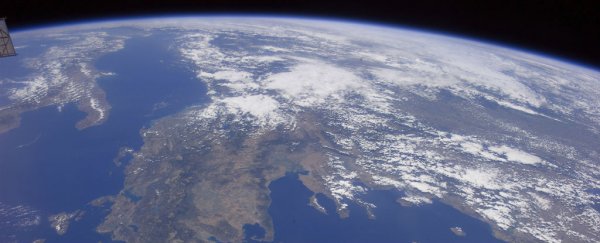Scientists have predicted that a rogue piece of space junk will impact Earth at 6:20 UTC on 13 November, falling into the Indian Ocean about 65 kilometres off the southern tip of Sri Lanka. Dubbed WT1190F, the curious object was rediscovered just this month after scientists lost track of its orbit far beyond the Moon and all but forgot about it.
Now the space debris, which is thought to measure between 1 and 2 metres long, is on a collision course with Earth, and presents a rare opportunity for scientists to watch the entire impact event from beginning to end.
Detected by the Catalina Sky Survey at the University of Arizona in the US a few weeks ago, WT1190F's trajectory has been calculated based on 2012 and 2013 sightings found in old telescope archives. According to Traci Watson at Nature News, it travels a highly elliptical orbit, swinging out twice as far as the Earth-Moon distance, its movements suggesting that it's low-density enough to be hollow on the inside.
This means what we're dealing with can't be a regular old chunk of space rock, so WT1190F is this thing?
"It could be a spent rocket stage or paneling shed by a recent Moon mission," says Watson. "It is also possible that the debris dates back decades, perhaps even to the Apollo era. An object seen orbiting the Earth in 2002 was eventually determined to be a discarded segment of the Saturn V rocket that launched the first men to land on the Moon."
Amazingly, if scientists do figure out that this thing was made by us and launched into space only to get separated and lost for several years, it will be the first known instance of our own space trash returning home. Or as Jonathan McDowell from the Harvard-Smithsonian Centre for Astrophysics puts it, "A lost piece of space history that's come back to haunt us."
Most, if not all, of the object is expected to burn up in Earth's atmosphere, and whatever's left will hurtle into the Indian Ocean. While there likely won't be much of WT1190F left at this point, independent astronomy software developer Bill Gray, who's been working with NASA to track the object, pointed out that, "I would not necessarily want to be going fishing directly underneath it." Noted.
While the impact is not expected to garner much of the world's attention, the scientists involved are certainly grateful for the opportunity to test out the global networks they've put in place for tracking much larger, more threatening cosmic visitors.
WT1190F might be the only impact we've got coming up in the near future (that we know about), but it's not the only close encounter we can look forward to in the coming weeks. On October 31, asteroid 2015 TB145 - a sizeable chunk of rock that's hurtling through space at speeds of over 126,000 km/h - is expected to draw closer to Earth than anything of its size since July 2006.
It's easy to forget that our planet is just a tiny part of a huge, buzzing, and incredibly crowded Solar System, filled with countless asteroids, comets, and a whole lot of trash. On November 13, we'll get a timely reminder that while the jury's still out on aliens, we're certainly not alone out here.
